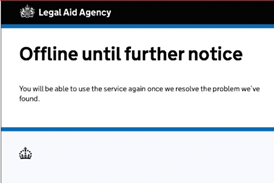The bulk of Lord Justice Jackson’s civil litigation reforms are a year old. Marialuisa Taddia speaks to senior practitioners about their impact so far.
Lord Justice Jackson’s reforms of the civil justice system promised to boost efficiency and reduce litigation costs. It is a position, he maintains, that will prevail after the ‘shock’ of his reforms has subsided. Speaking one year on from the introduction of the bulk of his proposed reforms, Jackson predicted that the old regime of uncontrolled litigation costs would be seen as ‘absurd’ in the future.
Taking a swipe at his many critics, Jackson added: ‘Every stakeholder group seems to perceive the public interest as residing in a state of affairs which coincides with its own commercial interest.’
It is early to fully assess the impact of the changes. Many had anticipated a ‘big bang’ when changes to civil litigation costs and funding were introduced on 1 April 2013 through the Legal Aid, Sentencing and Punishment of Offenders Act 2012 and new Civil Procedure Rules. But so far this has not happened.
However, according to the groups Jackson so readily dismissed, early indications suggest that claimants are being squeezed, leaving practitioners concerned that access to justice is being undermined.
The impact of the reforms has been mitigated in part because lawyers have been putting their heads in the sand, taking on a large number of cases before the 1 April deadline to avoid getting to grips with the new rules. As Hardwicke’s Charles Bagot puts it: ‘We are in a bit of a “phoney war” situation. There are still a lot of cases in the system under the old arrangements, and it is really this year that we are going to see the greater impact [of the reforms] because we have had the cushioning effect of all those cases signed up.’
Moreover, the first important decision by the courts implementing the new rules on costs management did not arrive until eight months after their introduction. In Mitchell v News Group Newspapers, the Court of Appeal sent out its clearest message yet to civil litigators that relief from sanctions will rarely be granted when a party fails to comply with court directions, rules and orders. In the case – the decision was reached on 27 November – the claimant solicitors missed a deadline to submit their costs budgets.
Francesca Kaye, a partner at Russell-Cooke and president of the London Solicitors Litigation Association, says: ‘Until the Mitchell decision, people were working on the basis that there was slightly more flexibility in applications for relief from sanctions.’
The Mitchell ruling
Mitchell has been a wake-up call for solicitors and barristers alike. Adding to the weight of the decision is that it does not just apply to claims that have been issued on or after 1 April.
‘Mitchell is the most significant decision in civil litigation, certainly since the Civil Procedure Rules came in in 1999,’ says Bagot. ‘Its importance cannot be overestimated. It has completely changed the way we do litigation.’ Before this judgment, parties were able either to agree an extension of time among themselves, or at least expected courts to be sympathetic.
Now, if they miss a deadline, the judge will require an application for relief from sanctions. ‘A lot of people are getting caught out, including very experienced firms of solicitors. They are getting a nasty shock,’ Bagot says.
Practitioners say that Mitchell may have had the opposite effect to the declared aim of the reforms, at least in the short term. Kaye says: ‘No one is risking anything, and everyone is making applications. Court lists are getting clogged up with lots of applications for extensions of time, and for relief from sanctions. This is slowing up the process in court and putting up costs.’
As this article was in preparation, it emerged that the Civil Procedure Rules are to be amended to allow parties to agree time extensions of up to 28 days for serving certain documents, without needing to make an application to the court. This is intended to alleviate the pressure being experienced by courts (see box).
Courts will also be getting busier with professional negligence claims brought by clients against their solicitors. Bagot predicts an ‘upsurge’ in such claims as courts take note of Mitchell and strike out cases for non-compliance with court deadlines. ‘That’s not going to make the courts quieter or save costs,’ he says. ‘The problem is that because the case is struck out, it is not going to go away. It comes back as a professional negligence claim against the solicitor,’ he concludes.
Compounding these problems, litigants are turning Mitchell’s strict approach to non-compliance with costs rules to their tactical advantage by opposing applications for relief from sanctions, even when there has only been a short delay.
Although courts are not concerned with ‘trivial’ breaches of the rules and procedures, Kaye notes: ‘We have now had a whole series of cases since November where different judges at different levels have had to make decisions about what was trivial and what wasn’t trivial, and when relief from sanctions should be granted or not. It is a bit of a mess at the moment, there is no consistency, or rather, if there is any consistency at all, it’s that you are hardly ever going to be granted relief from sanctions.’
Unpredictable decisions
Despite Mitchell, lawyers say courts and judges are still exercising their new costs management powers inconsistently. ‘It is almost impossible to predict what is going to happen on any costs order,’ adds Tim Hardy, head of CMS Cameron McKenna’s litigation department. He recounts a recent experience in court when he successfully opposed an application for security for costs made by the defendant against his client, but the latter was ordered to pay for the defendant’s costs of making the application.
Hardy adds: ‘In a funny sort of way, if Lord Justice Jackson wants parties to try and agree things without the court getting involved, then maybe it is going to have that effect because there is certainly going to be pressure to settle things, and not let the judge get near them because they are so unpredictable.’
The new requirement for parties to set, share and agree budgets at the very start of the court process does not just mean firms are giving different advice on the risks associated with costs orders. It is also altering some firms’ practice around costs with respect to litigation.
CMS Cameron McKenna was preparing detailed budgets and estimates well before the introduction of costs budgeting rules, and using Precedent H, a self-calculating spreadsheet detailing all litigation expenses.
But, says Hardy: ‘The importance of strategising around the costs is a new, unwelcome development. We are now writing so many more self-serving letters around costs issues. It becomes a hugely tactical minefield, wasting money and effort. It’s just further room for argument about issues, which actually aren’t to do with the merit of the case.’
If some firms are unhappy with Mitchell, it has been good news for others. Francis Kendall, a costs lawyer and partner at Masters Legal Costs Services, and a council member at the Association of Costs Lawyers (ACL), says that demand for costs budgeting work has increased exponentially: costs budgeting currently takes a third of Kendall’s time from virtually nothing four months ago, when the bulk of Kendall’s work was detailed assessments.
Masters, alongside other ACL members, was involved in costs management pilot schemes in defamation, and technology and construction courts between October 2009 and May 2013.
‘We are finding at the moment that it is a matter of one client latching on, and then suddenly we are getting all their budgeting work when they realise the value that we are adding to the process,’ Kendall says.
The average hourly rates in London for costs lawyers are in the region of £150-£200 and are comparable to those of a trainee solicitor at a major law firm.
‘Your average trainee solicitor is going to spend a hell of a lot more time than a costs lawyer preparing the budget because of our experience of doing it. Also, what we are finding it is that our clients are actually enjoying the sounding board element of running [the costs budget] by a separate person who is dealing with the costs side of things.’
Masters LCS’ clients come in all sizes, and include commercial and clinical negligence firms. ‘The recruitment market has gone haywire. Costs lawyers are in massive demand. Everybody is trying to employ us,’ Kendall claims.
What about litigation funding? The most significant change is that neither after-the-event (ATE) insurance premiums nor the solicitors’ uplift on basic costs in no win, no fee agreements are recoverable from the losing side.
Bagot argues that this is ‘very significant’, and probably not outweighed by the 10% increase in general damages, as well as the changes to the effect of part 36 offers to settle. To encourage earlier settlement of claims, where a claimant has made a part 36 offer on or after 1 April 2013, and a judgment at least as advantageous as the claimant’s part 36 offer is obtained, a defendant faces paying a penalty.
As a result, law firms and barristers chambers are more likely to turn down complex cases on liability and lower-value cases.
‘People are really thinking twice or three times about whether to take those cases on and run with them,’ says Bagot, who specialises in personal injury and clinical negligence. ‘Many [lawyers] are not keen to recover uplifts and insurance premiums from their own clients, and many firms and barristers are in the position where they are having to think, well, will I do this case on a 0% uplift effectively?
‘That’s a very different situation from knowing that you might get an uplift in other cases to soften the blow of a difficult case, which is run and then has to be abandoned later or is lost.’
Furthermore, in lower-value cases it is unlikely that there will be enough money in the compensation pot to pay for the uplift. In personal injury, the success fee is capped at 25% of damages, excluding damages for future care and loss, which are protected in their entirety.
The same applies to other areas of law, for example, commercial claims. ‘We have seen more prospective or indeed actual clients who come to us and decide not to pursue a particular claim because of the viability,’ says Kaye. An increasing number of clients are choosing not to enter CFAs or take out ATE premiums. Meanwhile, those with shallow pockets, but also with the more complex but less valuable claims, are struggling to find legal representation.
Adding to the funding squeeze on claimants and smaller firms is the new fixed-costs regime with the extension, from the end of July 2013, of the Ministry of Justice’s Road Traffic Accident (RTA) Portal scheme to handle claims up to £25,000 (up from £10,000), as well as employer and public liability claims. Fixed recoverable costs for claimant solicitors have been reduced drastically – in some cases by up to 60%.
Barristers have been cut out from the portal – and from fast-track cases – with the abolition of the disbursement basis for paying the bar.
‘That was the sort of work that junior barristers would get their experience from, before moving on to larger cases,’ says Bagot. ‘There is really a big impact in personal injury from a downturn in the volume of work, particularly at the most junior end of the bar, and there is a concern about how people are going to cut their teeth in this area.’
As for the impact of the extension of the scheme on solicitors, Tim Oliver, CEO of Parabis Group, which specialises in personal injury and owns defendant and claimant firms Plexus Law and Cogent Law, says: ‘It has certainly reduced the overall profitability of that type of work enormously, because you have more cases in the portal and they are at a fixed fee rather than an hourly rate, so the profit margin on these is definitely lower.’
Oliver adds: ‘We have had to re-engineer some of our processes to make sure that we have got the capacity and capability to deal with these claims very quickly.’
Despite the challenges, Parabis’ business model has not changed, and it continues to see the same level of high-volume work. Moreover, its claimant business, Cogent Law, has been cushioned from the effects of the new funding regime owing to referrals from insurance companies under a legal expenses policy – all claims are funded by before-the-event (BTE) insurance, instead of ATE insurance.
Parabis became an alternative business structure in September 2012 and is 50%-owned by private equity house Duke Street. As a result, it can withstand the new pressures.
However, Oliver says: ‘One of the downsides for the smaller firms is that they won’t be able to keep up with those efficiency drives to make sure that they are doing the work profitably so [the portal] has probably reduced the size of the legal market that supports [personal injury].’
As Bagot notes: ‘The funding pressure has come at the same time that courts have become much stricter about doing everything correctly and on time, and you can see a tension there. It’s very difficult for firms who are under pressure to do cases with less qualified staff in order to incur less costs, but if anything goes awry they are not going to get any mercy from the courts.’ He concludes: ‘I think it is a particular tough time in civil litigation.’
Edwin Coe senior partner David Greene argues that Jackson LJ sought greater access to justice by defendants locked out because of the recoverability of the CFA and of the recoverability of ATE premiums.
Budgeting for expert witnesses
Expert witnesses are a major cost in litigation and the Jackson reforms sought a greater focus on predicting and controlling these costs by changing the way expert witnesses are used.
Thayne Forbes, joint managing director of intellectual property specialist Intangible Business, says: ‘There is definitely a push to control the costs that are incurred to do with expert witnesses and costs budgeting is a tool to do that.’
For example, the use of single joint experts has increased since the reforms were introduced.
‘Having one expert, as opposed to two, is quite a big cost-saving measure, which is the main purpose of the Jackson report. It’s quite clear that the judiciary are trying to get a handle on the costs of litigation to make it more known and more controllable.’
Jackson has delivered in one other important area. Edwin Coe senior partner David Greene says: ‘There is one good thing coming out of the Jackson reforms and that is the predictability of adverse costs. There is effectively a costs-capping exercise in the budgeting, which allows claimants to know actually how much the adverse costs are going to be if they lose, and that does assist in project planning a claim.’
Defendant lawyers
But has the new regime rebalanced the power relationship between claimants and defendants?
David Johnson, president of the Forum of Insurance Lawyers (FOIL) and a partner at Weightmans, where he works with insurers focusing on personal injury litigation, says: ‘Making litigation a less costly process has meant that lawyers have seen reduced revenue flows, and because in many cases defendant lawyers were already working to fixed-costs arrangements with their clients, the impact has been most heavily felt by claimant lawyers.’ Johnson adds: ‘There has been a reduction in the cost of litigation, and I can only imagine that has been well received by the insurance community.’
But, Johnson notes, Mitchell is worrying both defendants and claimants. Although in Mitchell the court refused relief from sanctions to claimant solicitors, practitioners argue that the post-Jackson hardline approach to costs budgeting by the courts is going to catch out defendants.
Indeed, more so than claimants, who will have all their evidence, including witness statements, ready by the time they issue their case, leaving defendants to play catch-up to meet all the deadlines.
‘Justice Ramsey’s review will be interesting in that respect because the opportunities for claimants to front-end their cases and gain the strategic or tactical advantage over their opponents largely relate to the [timing advantage]they have in terms of what they do prior to issuing their proceedings,’ says Johnson.
‘Costs budgeting doesn’t cover the pre-litigation period. As I understand it, Ramsey has expressed an interest in looking at the pre-issue stage. It will be interesting to see whether that perceived advantage on the claimant’s part is addressed,’ Johnson says. Mr Justice Ramsey has been tasked with the reforms’ implementation, and has undertaken a review of some of the trickiest areas, including costs budgeting, pre-action costs and case management.
The lifecycle of a case means that funding changes are already having some impact. However, lawyers say that we have yet to see the impact of other aspects because they kick in at the end of the litigation process.
For example, a new regime of qualified one-way costs shifting (QOCS), introduced by the new CPR, is now implemented for personal injury cases. When a personal injury claimant loses their claim at trial, they are protected from having to pay the defendant costs – bar a few exceptions such as fundamental dishonesty.
Johnson says: ‘It’s still going to be some time before we see QOCS cases in sufficient volumes to understand all the implications of how QOCS works in practice. The courts will be called upon to interpret what fundamental dishonesty means and there may also be further case law around the interaction between Part 36 and QOCS, but we are not there yet.’ QOCS may be disapplied when the claimant fails to beat a defendant’s part 36 offer to settle.
Access to justice
Fundamental criticisms of the reforms continue to be voiced. ‘The opportunity that was missed was to look at base costs, and to put them under greater scrutiny by costs judges,’ says Bagot. ‘The reforms looked at the wrong issue, which is how much you should get on top of those base costs.’
Kaye observes: ‘All that the courts can attack is recoverable costs, not actual costs. They think that if they hit the recoverable costs enough times then eventually clients will ask questions, and the overall costs will come down. But there is a fundamental flaw in that: just because the recoverable cost is hit, it doesn’t mean that the cost of my sitting in this office here is reduced.’
The upshot, she says, is that the differential between what a client might recover if they are successful and what they might actually have to pay is increasing. ‘This is an access to justice issue,’ Kaye concludes.
The reforms by Jackson LJ aim to complete what Lord Woolf started in the 1990s: controlling the costs of litigation and making it more efficient. But they have come at a price. As Greene says: ‘Fewer people will be able to bring claims as a result.’
Marialuisa Taddia is a freelance journalist






























1 Reader's comment